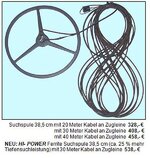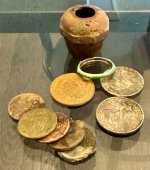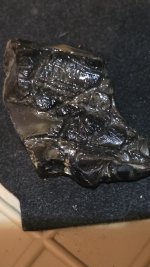Galleon Hunter
Full Member
FOR IMMEDIATE RELEASE
World-Renowned Historical Shipwrecks Change Hands, Nearly $1 Billion in Potential Treasure at Stake
Family that Prevailed in US Supreme Court Hands Over Torch to New Generation of Historical Shipwreck Salvors
-- Valuable Collection Including 300-Year Gold Portrait Pendant & “Doubloon” Just Discovered, Heralding Handover --
Sebastian, Florida – “1715 Fleet - Queens Jewels, LLC”, a private company, today announced that it has acquired the salvage rights to the 1715 Treasure Fleet (“1715 Fleet”) from the heirs of world-famous treasure hunter, Mel Fisher. The 1715 Fleet is considered one of the most important shipwreck fleets in history, laden with treasures bound for the King and Queen of Spain before wrecking in 1715 in a ferocious hurricane off Florida, launching the careers of pirates such as Blackbeard, Henry Jennings and the like. Nearly 275 years later, Fisher prevailed in US Supreme Court in his battle for the rights to numerous wrecks, resulting in US Admiralty Custodianship of the 1715 fleet. Now, the 1715 Fleet rights have been passed on to a new generation of shipwreck salvors who plan to invest heavily in salvage operations in hopes of recovering assorted antiquities -- including the Queen’s jewels -- estimated to be worth close to $900 million. Immediately upon acquiring the rights, Queens Jewels, LLC announced an historic archaeological find, a gold-rimmed portrait pendant just recovered from the ocean floor along with gold and silver coins and numerous other artifacts of historical importance.
“We are entering a new age of historical shipwreck salvaging,” said Brent Brisben, Operations Manager of 1715 Fleet - Queen’s Jewels, LLC, “As if to confirm our confidence, our subcontractor immediately recovered valuable pieces of history, hidden for nearly 300 years. With new technology, we hope larger discoveries are not far behind.”
The 1715 Fleet was a convoy of Spanish galleons that set sail from Cuba laden with precious cargo that included gold bars, coins, diamonds, emeralds and pearls originating from New World locations such as Columbia, Panama and Mexico, as well as from the Far East. The site of six of eleven sunken ships have been located, some in only 20 feet of water, but still not recovered are 300 chests containing nearly one million silver coins and the Queen’s jewels. Queen Isabella, the bride of King Philip V, refused to consummate their marriage until receiving a dowry, which was aboard the 1715 Fleet including a 74-carat emerald ring.
Now Queens Jewels, LLC will reinvigorate the search for that precious cargo. The remains of the fleet lie off the east coast of Florida between Sebastian and Stuart, the former approximately 40 miles south of Cape Canaveral and the latter 40 miles north of West Palm Beach.
Gold Hound Treasure Divers, one of the key shipwreck salvage operators on the 1715 Fleet for over a decade, uncovered the gold-rimmed portrait pendant treasure last week in only ten feet of water. Near it were also recovered a rare, 2 Escudo gold coin better known in pirate lore as a “doubloon”, five silver coins, a gold ring, pottery, iron artifacts, and a “dead-eye” -- part of a ship’s rigging, a wooden block with three holes through which critical mast lanyards are woven. The collection, especially the pendant, is among the most important finds in the last few years, some of which will likely end up in the State’s permanent museum collection. Florida is entitled to a percentage of all treasure finds from the 1715 Fleet, many of which are then shared in traveling exhibits with museums throughout the nation.
Added Gold Hound Treasure Divers Captain Greg Bounds about finding the treasure on a beautiful, calm day in crystal clear waters. “It was a day that dreams are made of. The treasure was in a spot that we’ve been eyeing, but technology led us to the exact location. This is a new century with new technology.” Bounds referred to a sophisticated magnetometer, which detects magnetic fields, such as that which gold emits.
The pendant, partially encrusted by nature, will now be meticulously treated by conservators with techniques that may help delineate the pigmentation within the portrait. A similar piece discovered years ago was of a woman, perhaps the wife of an officer aboard the fleet. Other possibilities are that the portrait might represent the figure of the Virgin Mary, given the deeply religious period from which the treasures originate. Such finds, according to Brisben, “give us the chance to learn about and possibly rewrite history.”
Mel Fisher discovered what is believed to be the largest shipwreck treasure ever, Nuestra Señora de Atocha (“Our Lady of Atocha”) off Key West on July 12, 1985. That discovery yielded 400 million dollars worth of treasures including 42 tons of silver and gold, and led to Fisher’s fight for the rights to his discovery, which was confirmed by the Supreme Court. His heirs retain those rights, as they did the 1715 Fleet Admiralty Custodianship prior to their sale to Queens Jewels LLC. Queens Jewels plans to institute “an enhanced and more systematic archaeological approach to salvaging the 1715 Fleet”.
More on the 1715 Fleet
It was all because of a woman. King Philip of Spain married the Duchess of Parma, Italy, but she refused to consummate the marriage until an enormous dowry was bestowed upon her. After years of war with England and the Dutch, however, the King’s coffers were depleted, so he dispatched ships to retrieve desperately needed riches accumulating on his behalf in the New World. The treasure fleet, with the two main ships alone carrying 14 million coins, set sail from Havana on July 24th, heading toward the Straits of Florida guided by a gentle breeze. Seven days later, on July 31st, a violent hurricane drove the ships on to jagged reefs, the entire fleet lost to the sea and over 1,000 of the 2,500 aboard perishing. The King’s officers, privateers and pirates salvaged some of the treasure, but much remained on the ocean floor forgotten for the ensuing 250 years. Modern salvage efforts began in the late 1950s, with Mel Fisher later acquiring salvage rights to the sites.
World-Renowned Historical Shipwrecks Change Hands, Nearly $1 Billion in Potential Treasure at Stake
Family that Prevailed in US Supreme Court Hands Over Torch to New Generation of Historical Shipwreck Salvors
-- Valuable Collection Including 300-Year Gold Portrait Pendant & “Doubloon” Just Discovered, Heralding Handover --
Sebastian, Florida – “1715 Fleet - Queens Jewels, LLC”, a private company, today announced that it has acquired the salvage rights to the 1715 Treasure Fleet (“1715 Fleet”) from the heirs of world-famous treasure hunter, Mel Fisher. The 1715 Fleet is considered one of the most important shipwreck fleets in history, laden with treasures bound for the King and Queen of Spain before wrecking in 1715 in a ferocious hurricane off Florida, launching the careers of pirates such as Blackbeard, Henry Jennings and the like. Nearly 275 years later, Fisher prevailed in US Supreme Court in his battle for the rights to numerous wrecks, resulting in US Admiralty Custodianship of the 1715 fleet. Now, the 1715 Fleet rights have been passed on to a new generation of shipwreck salvors who plan to invest heavily in salvage operations in hopes of recovering assorted antiquities -- including the Queen’s jewels -- estimated to be worth close to $900 million. Immediately upon acquiring the rights, Queens Jewels, LLC announced an historic archaeological find, a gold-rimmed portrait pendant just recovered from the ocean floor along with gold and silver coins and numerous other artifacts of historical importance.
“We are entering a new age of historical shipwreck salvaging,” said Brent Brisben, Operations Manager of 1715 Fleet - Queen’s Jewels, LLC, “As if to confirm our confidence, our subcontractor immediately recovered valuable pieces of history, hidden for nearly 300 years. With new technology, we hope larger discoveries are not far behind.”
The 1715 Fleet was a convoy of Spanish galleons that set sail from Cuba laden with precious cargo that included gold bars, coins, diamonds, emeralds and pearls originating from New World locations such as Columbia, Panama and Mexico, as well as from the Far East. The site of six of eleven sunken ships have been located, some in only 20 feet of water, but still not recovered are 300 chests containing nearly one million silver coins and the Queen’s jewels. Queen Isabella, the bride of King Philip V, refused to consummate their marriage until receiving a dowry, which was aboard the 1715 Fleet including a 74-carat emerald ring.
Now Queens Jewels, LLC will reinvigorate the search for that precious cargo. The remains of the fleet lie off the east coast of Florida between Sebastian and Stuart, the former approximately 40 miles south of Cape Canaveral and the latter 40 miles north of West Palm Beach.
Gold Hound Treasure Divers, one of the key shipwreck salvage operators on the 1715 Fleet for over a decade, uncovered the gold-rimmed portrait pendant treasure last week in only ten feet of water. Near it were also recovered a rare, 2 Escudo gold coin better known in pirate lore as a “doubloon”, five silver coins, a gold ring, pottery, iron artifacts, and a “dead-eye” -- part of a ship’s rigging, a wooden block with three holes through which critical mast lanyards are woven. The collection, especially the pendant, is among the most important finds in the last few years, some of which will likely end up in the State’s permanent museum collection. Florida is entitled to a percentage of all treasure finds from the 1715 Fleet, many of which are then shared in traveling exhibits with museums throughout the nation.
Added Gold Hound Treasure Divers Captain Greg Bounds about finding the treasure on a beautiful, calm day in crystal clear waters. “It was a day that dreams are made of. The treasure was in a spot that we’ve been eyeing, but technology led us to the exact location. This is a new century with new technology.” Bounds referred to a sophisticated magnetometer, which detects magnetic fields, such as that which gold emits.
The pendant, partially encrusted by nature, will now be meticulously treated by conservators with techniques that may help delineate the pigmentation within the portrait. A similar piece discovered years ago was of a woman, perhaps the wife of an officer aboard the fleet. Other possibilities are that the portrait might represent the figure of the Virgin Mary, given the deeply religious period from which the treasures originate. Such finds, according to Brisben, “give us the chance to learn about and possibly rewrite history.”
Mel Fisher discovered what is believed to be the largest shipwreck treasure ever, Nuestra Señora de Atocha (“Our Lady of Atocha”) off Key West on July 12, 1985. That discovery yielded 400 million dollars worth of treasures including 42 tons of silver and gold, and led to Fisher’s fight for the rights to his discovery, which was confirmed by the Supreme Court. His heirs retain those rights, as they did the 1715 Fleet Admiralty Custodianship prior to their sale to Queens Jewels LLC. Queens Jewels plans to institute “an enhanced and more systematic archaeological approach to salvaging the 1715 Fleet”.
More on the 1715 Fleet
It was all because of a woman. King Philip of Spain married the Duchess of Parma, Italy, but she refused to consummate the marriage until an enormous dowry was bestowed upon her. After years of war with England and the Dutch, however, the King’s coffers were depleted, so he dispatched ships to retrieve desperately needed riches accumulating on his behalf in the New World. The treasure fleet, with the two main ships alone carrying 14 million coins, set sail from Havana on July 24th, heading toward the Straits of Florida guided by a gentle breeze. Seven days later, on July 31st, a violent hurricane drove the ships on to jagged reefs, the entire fleet lost to the sea and over 1,000 of the 2,500 aboard perishing. The King’s officers, privateers and pirates salvaged some of the treasure, but much remained on the ocean floor forgotten for the ensuing 250 years. Modern salvage efforts began in the late 1950s, with Mel Fisher later acquiring salvage rights to the sites.








